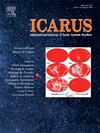Chromium isotopes in CR chondrites reveal two distinct chondrule reservoirs
IF 3
2区 物理与天体物理
Q2 ASTRONOMY & ASTROPHYSICS
引用次数: 0
Abstract
Chondrules, the dominant components of chondrites, provide crucial insights into early solar system formation and evolution. Due to the variability of Cr isotopes in the solar system, they can serve as powerful tracers of chondrule genealogy and the transport of precursor materials in the evolving solar disk. High-precision mass-independent Cr isotope data for individual chondrules from the CR chondrite Shişr 033 reveal a bimodal distribution of ε54Cr that defines two isotopically distinct chondrule populations. The major population exhibits ε54Cr values (∼1.3) consistent with prior analyses of CR chondrules, while a minor population has significantly lower ε54Cr (∼0.8), overlapping with CV-CO-CM chondrules. This suggests chondrule migration across spatial gaps in the protoplanetary disk, likely from the CV-CO-CM reservoir to the CR sub-reservoir. Further, 53Mn–53Cr systematics indicate that Mn–Cr fractionation in CR chondrule precursors occurred ∼0.7 Ma after solar system formation, predating the primary CR chondrule formation event at ∼3.8 Ma, inferred from 26Al–26Mg, and 182Hf–182W chronometry of individual chondrules. These findings support a model in which secondary disk substructures, likely linked to early Jupiter growth, facilitated isotopic heterogeneities and material transport in the outer solar system. The presence of CV-CO-CM chondrules in CR chondrites further suggests outward material transport in the protoplanetary disk before CR parent body accretion. This study provides new constraints on chondrule formation, precursor evolution, and planetary disk dynamics.
CR球粒陨石中的铬同位素揭示了两个不同的球粒储集层
球粒是球粒陨石的主要组成部分,为早期太阳系的形成和演化提供了至关重要的见解。由于太阳系中Cr同位素的可变性,它们可以作为球粒谱系和演化中的太阳盘前体物质运输的有力示踪剂。Cr球粒陨石shi r 033中单个球粒的高精度质量无关Cr同位素数据揭示了ε54Cr的双峰分布,定义了两个同位素不同的球粒种群。主要种群的ε54Cr值(~ 1.3)与先前的CR球粒分析结果一致,而少数种群的ε54Cr值(~ 0.8)显著降低,与CV-CO-CM球粒重叠。这表明球粒在原行星盘的空间间隙中迁移,可能是从CV-CO-CM储层到CR亚储层。此外,53Mn-53Cr系统表明,CR球粒前体中的Mn-Cr分异发生在太阳系形成后约0.7 Ma,早于最初的CR球粒形成事件约3.8 Ma,这是由单个球粒的26Al-26Mg和182Hf-182W计时推断的。这些发现支持了一个模型,在这个模型中,次级盘亚结构可能与早期木星的生长有关,促进了外太阳系的同位素非均质性和物质运输。CR球粒中CV-CO-CM球粒的存在进一步表明,在CR母体吸积之前,原行星盘中的物质向外输送。这项研究为球粒形成、前体演化和行星盘动力学提供了新的约束。
本文章由计算机程序翻译,如有差异,请以英文原文为准。
求助全文
约1分钟内获得全文
求助全文
来源期刊

Icarus
地学天文-天文与天体物理
CiteScore
6.30
自引率
18.80%
发文量
356
审稿时长
2-4 weeks
期刊介绍:
Icarus is devoted to the publication of original contributions in the field of Solar System studies. Manuscripts reporting the results of new research - observational, experimental, or theoretical - concerning the astronomy, geology, meteorology, physics, chemistry, biology, and other scientific aspects of our Solar System or extrasolar systems are welcome. The journal generally does not publish papers devoted exclusively to the Sun, the Earth, celestial mechanics, meteoritics, or astrophysics. Icarus does not publish papers that provide "improved" versions of Bode''s law, or other numerical relations, without a sound physical basis. Icarus does not publish meeting announcements or general notices. Reviews, historical papers, and manuscripts describing spacecraft instrumentation may be considered, but only with prior approval of the editor. An entire issue of the journal is occasionally devoted to a single subject, usually arising from a conference on the same topic. The language of publication is English. American or British usage is accepted, but not a mixture of these.
 求助内容:
求助内容: 应助结果提醒方式:
应助结果提醒方式:


